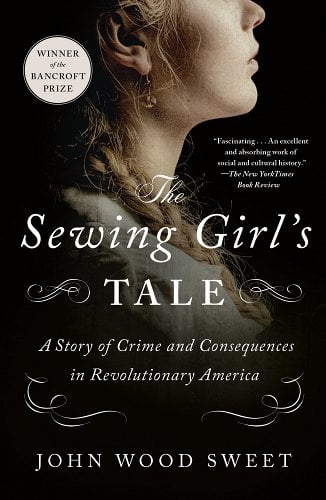
John Wood Sweet has received the distinguished honor of the 2023 Bancroft Prize for his book The Sewing Girl’s Tale, becoming the first UNC faculty member to receive the coveted prize since the 1960s. The Bancroft Prize is one of the highest honors in the field of American history, reserved for exceptional academic work in the discipline. It is awarded annually by Columbia University, which describes the prize as honoring works of “enduring worth and impeccable scholarship that make a major contribution to our understanding of the American past.” The book has also received the Book of the Year Award from the Journal of the American Revolution, the New York City Book Award winner, New York Times’ Editor’s Choice, the Gotham Book Prize, and the 67th Francis Parkman Prize by the Society of American Historians (SAH) at Columbia University.
The Sewing Girl’s Tale recounts and interprets the first published rape trial in American history, in New York in the 1790s. The book traces the story of Lanah Sawyer, a seventeen-year-old seamstress who attempted to bring her attacker to justice through the courts. This story is an anomaly for the time – it was rare for a paper trail to exist for cases such as this one, if they even went to trial at all. The outcome of Sawyer’s trial was controversial, and led to riots in the streets of New York. However, the acquittal of the assailant was not the end of the story, and Lanah Sawyer did not give up her fight for justice and agency. Sweet sought to center Sawyer in his writing at all times, and discuss her story beyond the trial that she is best known for. Sweet examines her life before, during, and after the trial to draw larger conclusions about life post-American Revolution New York.

Sweet has been interested in Sawyer’s story for decades. He often used her trial when teaching undergraduates about the historical roots of modern rape culture. His perspective shifted when a graduate student he was working with found a reference about the trial that he had never seen before. Sweet realized that there was much more to Sawyer’s story, which continued on long after the initial trial. The complexities he found challenged his previous assumptions about the trial, prompting Sweet to undertake further research to help him understand the entire picture. The Sewing Girl’s Tale is the outcome of this deeper investigation into Lanah Sawyer and her life. The book took twelve years to complete as Sweet meticulously gathered and analyzed a variety of sources, which ranged from letters, diaries, and newspapers to material items such as dresses and silverware.
Lanah Sawyer’s story continues to help engage the undergraduates that he teaches. Sweet has shared portions of the book with his students, valuing the perspective they bring to the story. Students from Sweet’s History of Sexuality seminar even helped him to choose the right audiobook narrator. “Undergraduates are about the age that Lanah Sawyer was during the trial,” explained Sweet, “I’ve learned a lot from engaging with them on this topic and on this case.” He also points out the continuing relevance of the story to the modern day rape culture, victim blaming, and inequities in the criminal justice system that students are familiar with. Sawyer’s story can help them understand the historical patterns inherent in seemingly modern concepts.
What’s next for John Wood Sweet? When I asked, he told me about a forthcoming project: a biography of Venture Smith, an African-born New Englander who wrote the first published American slave narrative. Sweet initially set the project aside, but writing a character-driven story in The Sewing Girl’s Tale inspired him to revisit Smith’s story. “The Lanah Sawyer trial has helped me to figure out how to write Smith’s story,” he said, “I want to center his struggles, the drama of his life, and the development of his character over time.”
The History Department congratulates John Wood Sweet on his well-deserved honors!
– Dani McIvor
